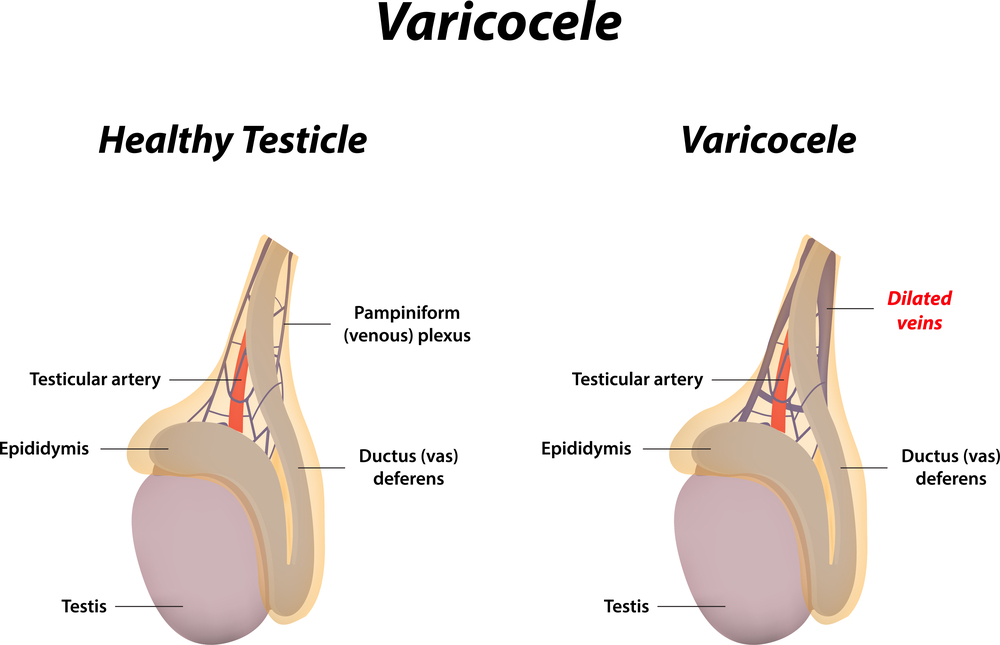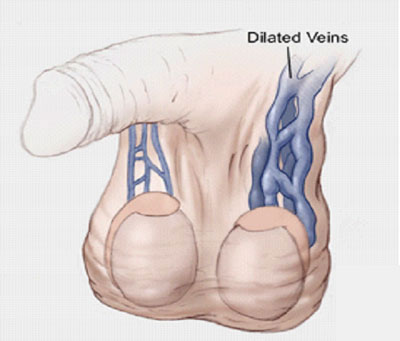Now available at Breach Candy Hospital on Wednesdays 07:00 pm to 08:00 pm


Dr. Dilip Raja
Urologist & Andrologist
Varicocele
15% of all men and 40% of infertility patients are found to have a varicocele
Get in touch with us today (022) 2645 2007
Varicocele is an abnormal & tortuous dilatation of the veins of the pampiniform plexus of the spermatic cord and is most commonly diagnosed by physical exam, (feeling of a bag of worms) or color duplex Doppler ultrasound (where vein measurement and blood flow patterns are observed). Varicocele rarely becomes clinically evident before early adolescence. Once present, they are not thought to regress.
Incidence
15% of all men and 40% of infertility patients are found to have a varicocele. Approximately 90% are left side sided and 10% are bilateral.
Etiology (Cause)
There are many theories as to the reason varicocele occur:
- The left internal spermatic vein is 8-10 centimeters longer than the right and acts as a hydrostatic column with increased pressure in the upright position.
- There are 40% fewer valves in the left spermatic veins as compared with 23% fewer on the right.
- “Nutcracker Phenomenon” (compression of the left renal vein between major blood vessels) with increased pressure in the left internal spermatic vein.
Problems Caused by Varicocele
- Elevated scrotal temperatures alter development maturation of sperm.
- Stagnation of blood around the testicles.
- Loss of testicular mass at the microscopic level.
- A varicocele on one side can deleteriously affect that testicle as well as the opposite testicle.
Symptoms
Typical varicocele symptoms are mild and many do not require treatment. Treatment may be necessary if the varicocele is causing discomfort or any of the other problems listed below.


Effects Of Varicocele
- Pain: One of the signs of varicocele is an aching pain when the individual has been standing or sitting for an extended time and pressure builds up in the affected veins. Heavy lifting or exercising in a gym may make varicocele symptoms worse and, in some cases, can even cause varicocele to form. Usually (but not always) painful varicocele are prominent in size.
- Testicular Atrophy: Atrophy, or shrinking, of the testicles is another of the signs of varicocele. The condition is often diagnosed in adolescent boys during a sports physical exam. When the affected testicle is smaller than the other, repair of the varicocele is often recommended. The repaired testicle will return to normal size in many cases.
- Fertility Problems: There is an association between varicocele and infertility or sub fertility, but it is difficult to be certain if a varicocele is the cause of fertility problems in any one case. In one study, as many as 40 percent of men, who were sub fertile were found to have a varicocele. Other signs of varicocele can be a decreased sperm count; decreased motility, or movement, of sperm; and an increase in the number of deformed sperm. It is not known for sure how varicocele contributes to these problems, but a common theory is that the condition raises the temperature of the testicles and affects sperm production. Studies have shown that from 50 percent to 70 percent of men with fertility problems will have a significant improvement in the quality and/or quantity of sperm production after they have undergone varicocele repair.
Treatment Of Varicocele
- Micro Surgical Varicocelectomy (Inguinal and Sub inguinal Ligation) Inguinal Approach is most preferred to prevent recurrence and magnification during the surgery is a must to save the testicular artery.
- Percutaneous Radiographic Embolization – Not Recommended
- Retroperitoneal & Laparoscopic Ligation (Palomos)
- This method of treating varicocele has been given up long back as there is high incidence of recurrence of varicocele.
- Recommendations after Surgery
- No heavy weight lifting for 30 days
- No sexual activity for four weeks
Low ligation of Varicocele under magnification (Micro surgery) is the ideal surgery for the treatment of varicocele.
